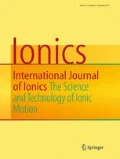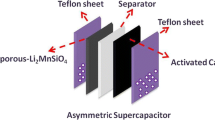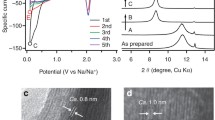Abstract
We report electrochemical performance of a calcium ferrite type NaFeTiO4 electrode for capacitor cell applications. High-resolution transmission electron microscopy results confirmed single-phase polycrystalline surface property comprising non-uniform grain distribution. X-ray photoelectron spectrum (XPS) analysis results confirmed presence of Fe3+ and Ti4+ oxidation states. The electrochemical performance of NaFeTiO4 in a three-electrode capacitor cell using different aqueous electrolytes: 1 M H2SO4, 1 M Na2SO4, and 1 M Li2SO4 confirmed superior performance only for capacitor cell with 1 M H2SO4 exhibiting typical pseudo-capacitive response in cyclic voltammetry. In contrast, the cell response of NaFeTiO4 with 1 M Na2SO4 and 1 M Li2SO4 electrolytes was electric double-layer charge (EDLC) accumulation induced capacitive effect predominantly. The electrolyte-driven distinct charge storage mechanism has been attributed to surface adsorption-induced redox action in the former whereas the EDLC response in the latter is attributed to larger size of the hydrated Na+ and Li+ ions causing charge accumulation at the interface. An excellent cyclic stability up to 10000 cycle with capacity retention up to 91% and coulombic efficiency ~ 100% has been noted @ 1 Ag−1 in 1 M H2SO4. Two electrode symmetric cell results exhibit similar pseudo-capacitive response as in three electrode cell configuration. The material delivered maximum power density ~ 18 kW/kg @ 10 Ag−1 and energy density ~ 2.55 Wh/kg @ 0.1 Ag−1 in a three-electrode-cell configuration whereas for a two-electrode cell, corresponding values are ~ 3.13 kW/kg @ 0.43Ag−1 and ~ 2.26 Wh/kg @ 0.04 Ag−1.












Similar content being viewed by others
References
Reddy MV, Mauger A, Julien CM et al (2020) Brief history of early lithium-battery development. Materials (Basel) 13:1–9. https://doi.org/10.3390/MA13081884
Reddy MV, Subba Rao GV, Chowdari BVR (2013) Metal oxides and oxysalts as anode materials for Li ion batteries. Chem Rev 113:5364–5457. https://doi.org/10.1021/cr3001884
Gamby J, Taberna PL, Simon P et al (2001) Studies and characterisations of various activated carbons used for carbon/carbon supercapacitors. J Power Sources 101:109–116. https://doi.org/10.1016/S0378-7753(01)00707-8
An KH, Kim WS, Park YS et al (2001) Supercapacitors using singlewalled carbon nanotube electrodes. AIP Conf Proc 590:241–244. https://doi.org/10.1063/1.1420099
Li J, Wang X, Huang Q et al (2006) Studies on preparation and performances of carbon aerogel electrodes for the application of supercapacitor. J Power Sources 158:784–788. https://doi.org/10.1016/j.jpowsour.2005.09.045
Chen LF, Zhang XD, Liang HW et al (2012) Synthesis of nitrogen-doped porous carbon nanofibers as an efficient electrode material for supercapacitors. ACS Nano 6:7092–7102. https://doi.org/10.1021/nn302147s
Zhang LL, Zhao XS (2009) Carbon-based materials as supercapacitor electrodes. Chem Soc Rev 38:2520–2531. https://doi.org/10.1039/b813846j
Meng C, Liu C, Chen L et al (2010) Highly flexible and all-solid-state paperlike polymer supercapacitors. Nano Lett 10:4025–4031. https://doi.org/10.1021/nl1019672
Snook GA, Kao P, Best AS (2011) Conducting-polymer-based supercapacitor devices and electrodes. J Power Sources 196:1–12. https://doi.org/10.1016/j.jpowsour.2010.06.084
Zhao Y, Liu B, Pan L, Yu G (2013) 3D nanostructured conductive polymer hydrogels for high-performance electrochemical devices. Energy Environ Sci 6:2856–2870. https://doi.org/10.1039/c3ee40997j
Yue B, Wang C, Ding X, Wallace GG (2012) Polypyrrole coated nylon lycra fabric as stretchable electrode for supercapacitor applications. Electrochim Acta 68:18–24. https://doi.org/10.1016/j.electacta.2012.01.109
Ingram MD, Staesche H, Ryder KS (2004) “Activated” polypyrrole electrodes for high-power supercapacitor applications. Solid State Ionics 169:51–57. https://doi.org/10.1016/j.ssi.2002.12.003
Liu J, Wang J, Xu C et al (2018) Advanced energy storage devices: basic principles, analytical methods, and rational materials design. Adv Sci 5. https://doi.org/10.1002/advs.201700322
Paul S, Choi KS, Lee DJ et al (2012) Factors affecting the performance of supercapacitors assembled with polypyrrole/multi-walled carbon nanotube composite electrodes. Electrochim Acta 78:649–655. https://doi.org/10.1016/j.electacta.2012.06.088
Jow TR, Zheng JP (1995) Amorphous thin film ruthenium oxide as an electrode material for electrochemical capacitors. Mater Res Soc Symp Proc 393:433–438
Hu CC, Tsou TW (2002) Ideal capacitive behavior of hydrous manganese oxide prepared by anodic deposition. Electrochem Commun 4:105–109. https://doi.org/10.1016/S1388-2481(01)00285-5
Wang Y, Lei Y, Li J et al (2014) Synthesis of 3D-nanonet hollow structured Co3O4 for high capacity supercapacitor. ACS Appl Mater Interfaces 6:6739–6747. https://doi.org/10.1021/am500464n
Xia XH, Tu JP, Wang XL et al (2011) Hierarchically porous NiO film grown by chemical bath deposition via a colloidal crystal template as an electrochemical pseudocapacitor material. J Mater Chem 21:671–679. https://doi.org/10.1039/c0jm02784g
Yang J, Lan T, Liu J et al (2013) Supercapacitor electrode of hollow spherical V2O5 with a high pseudocapacitance in aqueous solution. Electrochim Acta 105:489–495. https://doi.org/10.1016/j.electacta.2013.05.023
Wu NL (2002) Nanocrystalline oxide supercapacitors. Mater Chem Phys 75:6–11. https://doi.org/10.1016/S0254-0584(02)00022-6
Zheng FL, Li GR, Ou YN et al (2010) Synthesis of hierarchical rippled Bi2O3 nanobelts for supercapacitor applications. Chem Commun 46:5021–5023. https://doi.org/10.1039/c002126a
Xie K, Li J, Lai Y et al (2011) Highly ordered iron oxide nanotube arrays as electrodes for electrochemical energy storage. Electrochem Commun 13:657–660. https://doi.org/10.1016/j.elecom.2011.03.040
Chen J, Huang K, Liu S (2009) Hydrothermal preparation of octadecahedron Fe3O4 thin film for use in an electrochemical supercapacitor. Electrochim Acta 55:1–5. https://doi.org/10.1016/j.electacta.2009.04.017
Zheng L, Xu Y, Jin D, Xie Y (2010) Well-aligned molybdenum oxide nanorods on metal substrates: Solution-based synthesis and their electrochemical capacitor application. J Mater Chem 20:7135–7143. https://doi.org/10.1039/c0jm00744g
Karthikeyan K, Kalpana D, Renganathan NG (2009) Synthesis and characterization of ZnCo2O4 nanomaterial for symmetric supercapacitor applications. Ionics (Kiel) 15:107–110. https://doi.org/10.1007/s11581-008-0227-y
Gao X, Wang W, Bi J et al (2019) Morphology-controllable preparation of NiFe2O4 as high performance electrode material for supercapacitor. Electrochim Acta 296:181–189. https://doi.org/10.1016/j.electacta.2018.11.054
Chen H, Jiang J, Zhang L et al (2014) Facilely synthesized porous NiCo2O4 flowerlike nanostructure for high-rate supercapacitors. J Power Sources 248:28–36. https://doi.org/10.1016/j.jpowsour.2013.09.053
Kuo SL, Wu NL (2005) Electrochemical capacitor of MnFe2O4 with NaCl electrolyte. Electrochem Solid-State Lett 8:495–499. https://doi.org/10.1149/1.2008847
Zhang BH, Liu Y, Chang Z et al (2014) Nanowire Na0.35MnO2 from a hydrothermal method as a cathode material for aqueous asymmetric supercapacitors. J Power Sources 253:98–103. https://doi.org/10.1016/j.jpowsour.2013.12.011
Chen H, Shen Z, Pan Z et al (2019) Hierarchical micro-nano sheet arrays of nickel – cobalt double hydroxides for high-rate Ni – Zn batteries. Adv Sci 6:1802002. https://doi.org/10.1002/advs.201802002
Guan C, Liu X, Ren W et al (2017) Rational design of metal-organic framework derived hollow NiCo2O4 arrays for flexible supercapacitor and electrocatalysis. Adv Energy Mater 7:1–8. https://doi.org/10.1002/aenm.201602391
Tao Y, Wu Y, Chen H et al (2020) Synthesis of amorphous hydroxyl-rich Co3O4 for flexible high-rate supercapacitor. Chem Eng J 396:125364. https://doi.org/10.1016/j.cej.2020.125364
Vijayan BL, Mohd Zain NK, Misnon II et al (2020) Void space control in porous carbon for high-density supercapacitive charge storage. Energy Fuel 34:5072–5083. https://doi.org/10.1021/acs.energyfuels.0c00737
Vijayan BL, Misnon II, Anil Kumar GM et al (2020) Facile fabrication of thin metal oxide films on porous carbon for high density charge storage. J Colloid Interface Sci 562:567–577. https://doi.org/10.1016/j.jcis.2019.11.077
Harilal M, Krishnan SG, Pal B et al (2018) Environment-modulated crystallization of Cu2O and CuO nanowires by electrospinning and their charge storage properties. Langmuir 34:1873–1882. https://doi.org/10.1021/acs.langmuir.7b03576
Harilal M, Krishnan SG, Vijayan BL et al (2017) Continuous nanobelts of nickel oxide–cobalt oxide hybrid with improved capacitive charge storage properties. Mater Des 122:376–384. https://doi.org/10.1016/j.matdes.2017.03.024
Harilal M, Krishnan SG, Yar A et al (2017) Pseudocapacitive charge storage in single-step-synthesized CoO-MnO2-MnCo2O4 hybrid nanowires in aqueous alkaline electrolytes. J Phys Chem C 121:21171–21183. https://doi.org/10.1021/acs.jpcc.7b06630
Nwanya AC, Jafta CJ, Ejikeme PM et al (2014) Electrochromic and electrochemical capacitive properties of tungsten oxide and its polyaniline nanocomposite films obtained by chemical bath deposition method. Electrochim Acta 128:218–225. https://doi.org/10.1016/j.electacta.2013.10.002
Mandal B, Thakur AK (2018) Evaluation of NaFeTiO4 as an electrode for energy storage application. Ionics (Kiel) 24:1065–1074. https://doi.org/10.1007/s11581-017-2281-9
Naumkin A V, Kraut-Vass A, Gaarenstroom SW, Powell CJ (2012) NIST X-ray Photoelectron Spectrometry Database. NIST Stand Ref Database 20, Version 41
Šutka A, Kodu M, Pärna R, Saar R, Juhnevica I, Jaaniso R, Kisan V (2016) Orthorhombic CaFe2O4: a promising p-type gas sensor. Sensors Actuators B 224:260–265. https://doi.org/10.1016/j.snb.2015.10.041
Jedsukontorn T, Ueno T, Saito N, Hunsom M (2017) Facile preparation of defective black TiO2 through the solution plasma process: effect of parametric changes for plasma discharge on its structural and optical properties. J Alloys Compd 726:567–577. https://doi.org/10.1016/j.jallcom.2017.08.028
Ho Y-C, Huang F-M, Chang Y-C (2005) Biodegradable polymer–silica xerogel composite microspheres for controlled release of gentamicin. J Biomed Mater Res B Appl Biomater 83:340–344. https://doi.org/10.1002/jbmb
Reddy MV, Sharma N, Adams S et al (2015) Evaluation of undoped and M-doped TiO2, where M = Sn, Fe, Ni/Nb, Zr, V, and Mn, for lithium-ion battery applications prepared by the molten-salt method. RSC Adv 5:29535–29544. https://doi.org/10.1039/c5ra00206k
Xiao S, Xu P, Peng Q et al (2017) Layer-by-layer assembly of polyelectrolyte multilayer onto PET fabric for highly tunable dyeing withwater soluble dyestuffs. Polymers (Basel) 9. https://doi.org/10.3390/polym9120735
Zhong C, Deng Y, Hu W, et al (2016) Electrolytes for electrochemical supercapacitors. Electrolytes Electrochem Supercapacitors 1–335. https://doi.org/10.1201/b21497-3
Acknowledgements
The authors are thankful to the Ministry of Human Resource & Development (MHRD), Govt. of India for financial and infrastructural support by Indian Institute of Technology Patna.
Funding
This study is funded by the Ministry of Human Resource & Development (MHRD), Govt. of India.
Author information
Authors and Affiliations
Corresponding author
Additional information
Publisher’s note
Springer Nature remains neutral with regard to jurisdictional claims in published maps and institutional affiliations.
Rights and permissions
About this article
Cite this article
Mandal, B., Thakur, A.K. Electrode response of NaFeTiO4 in aqueous supercapacitor cells. Ionics 27, 1709–1721 (2021). https://doi.org/10.1007/s11581-021-03938-w
Received:
Revised:
Accepted:
Published:
Issue Date:
DOI: https://doi.org/10.1007/s11581-021-03938-w




